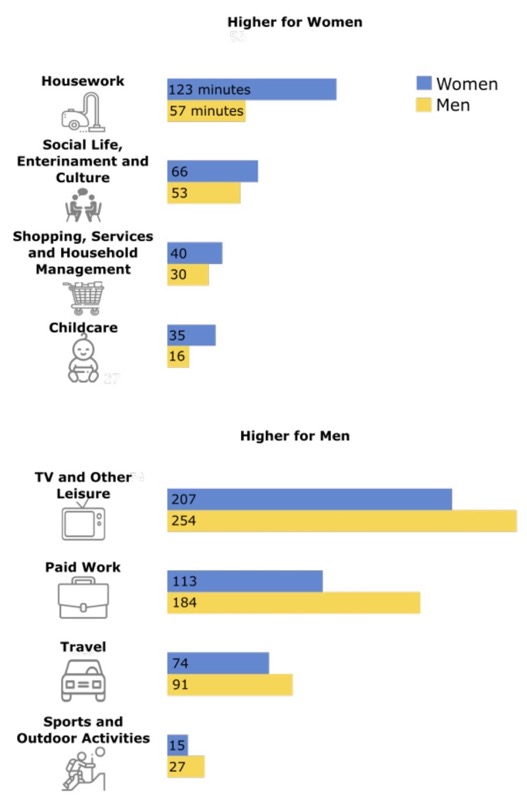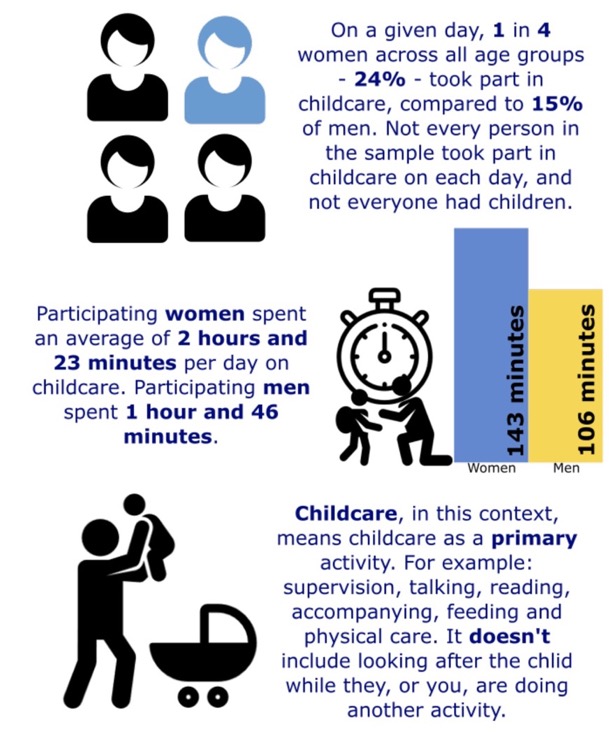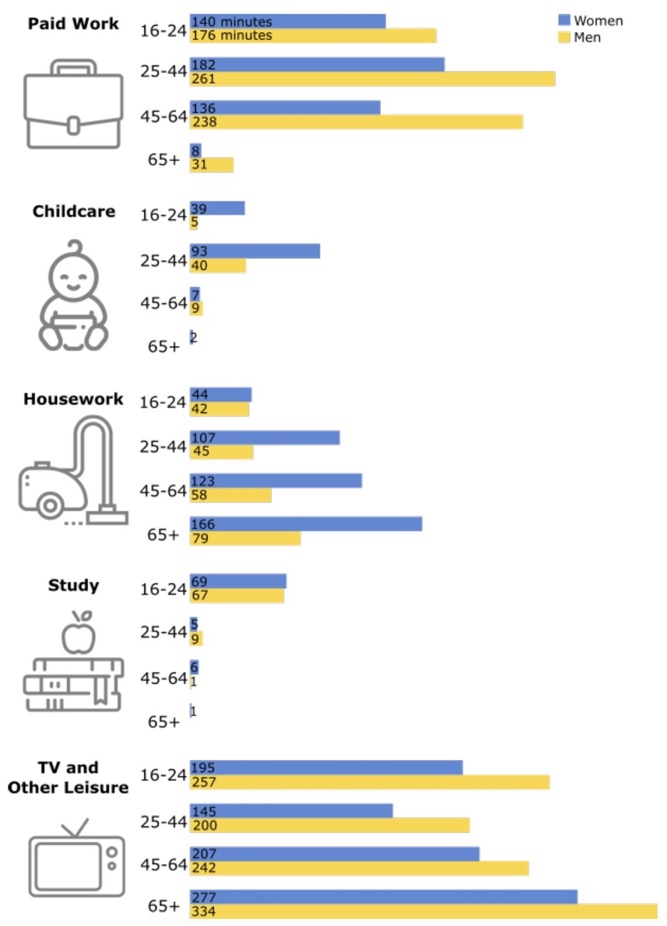Time use survey 2014-2015: results for Scotland
Analysis of the Scottish results of the 2014-2015 time use survey by Centre for Time Use, Oxford University.
1. Executive Summary
This report analyses the Scottish sample of the 2014-15 Time Use Study undertaken by the Centre for Time Use Research (CTUR) at the University of Oxford. The results primarily refer to the Scottish sample of 799 individuals who, in total, produced 1,052 diary days. These comprised of 498 diary days recorded by men and 554 recorded by women.
Participants filled in time use diaries detailing their daily activities. The main activities analysed in this report include the following:
- Paid work
- Unpaid work which includes a large number of variables, including housework; shopping services and household management; childcare; travel; construction and repairs; and voluntary work
- Study
- Leisure: which includes categories of TV and other leisure; social life, culture and entertainment; and sports and outdoor leisure
The data was analysed to determine where different groups exhibited different average daily time use. It reports significant variations in time use that emerge in relation to differences in gender, age, disability and income. Data from the same survey concerning the rest of the UK and time use data from 2000-01 is used for comparison where relevant.
Average time use depends on two factors: the number of people participating in an activity on a given day and the amount of time spent participating in that activity. These factors are combined to give a figure for average time use for the population group. Activities that everyone participates in for a short time may look similar to activities that are very time consuming for a smaller sub-group of people. The following example illustrates this. Based on the survey data, on a randomly selected day, only 24% of women would be predicted to be spending time on childcare. The other 76% of women in the sample would not be participating in childcare on that day, which may be a result of, for example, not having children or having children who have left home.
However, amongst those women who were participating in childcare on a given day, this was a time consuming activity that took an average of two hours 23 minutes per day. However, when averaged out over the whole sample, including participating and non-participating women, an average of 35 minutes was spent per day by women on child care. All time use figures need to be considered in terms of both the proportion of the population group participating in the activity on a given day – the daily participation rate - and the average time spent on the activity in question.
In the Scottish sample, the time spent in paid work declined from an average of 164 minutes per day in 2000-01 to an average of 148 minutes per day in 2014-15. This result was not statistically significant. However, a similar decline in paid work for the rest of the UK, and based on a larger data sample, was statistically significant.
An average of 270 minutes per day was spent on unpaid work in the Scottish sample. There were no significant differences in the time spent on unpaid work between Scotland and the rest of the UK, or between the 2000-01 and 2014-15 Scottish surveys.
In terms of gender differences, the principal findings are:
- Men spent more time in paid work.
- Women spent more time on ‘unpaid work’. The unpaid work category combined the variables of housework, childcare, construction and repairs, gardening and pet care, shopping, services and household management, childcare for others, help to others, volunteering and travel.
- Within ‘unpaid work’, women spent more time on childcare, housework and shopping, services and household management, while men spent more time on construction and repairs and travel (which includes both travel for leisure and commuting).
- In addition, men spent more time on sports and outdoor activities and the activities classed as ‘TV other leisure’. Women spent more time on activities classed as social life, culture and entertainment.
- In relation to the other variables, the principal findings were:
- Men and women aged 65 and over spent less time at work and more time on TV and other leisure than those in younger age groups.
- Those aged 25-44, in the primary child-bearing ages, spent more time on caring for their own children compared to other age groups.
- Those aged 16-24 spent more time studying compared to other age groups.
- Disabled people[1] spent less time in paid work, childcare, travel and study, while spending more time on ‘TV and other leisure’, when compared to non-disabled people.
- Those with incomes in the top 25% and middle 50% of the distribution spent more time on paid work than those in the bottom 25% of the distribution.
Figure 1: Average Time Use per day by Gender for Selected Activities[2]

Figure 2: Clarification on Time Use and Childcare

Figure 3: Average Time Use per day by Gender and Age on Selected Activities[3]

Contact
Email: Claire McHarrie
There is a problem
Thanks for your feedback